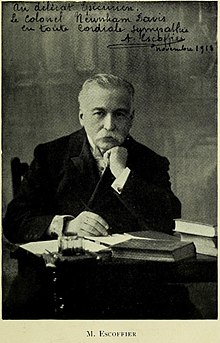Auguste Escoffier | |
|---|---|
 | |
| Born | Georges Auguste Escoffier 28 October 1846 Villeneuve-Loubet, France |
| Died | 12 February 1935 (aged 88) Monte Carlo, Monaco |
| Occupation(s) | Chef, restaurateur, writer |
| Spouse |
Delphine Daffis
(m. 1878; died 1935) |
| Children | Paul, Daniel, Germaine |
| Signature | |
 | |
Georges Auguste Escoffier (French: [ʒɔʁʒ oɡyst ɛskɔfje]; 28 October 1846 – 12 February 1935) was a French chef, restaurateur, and culinary writer who popularised and updated traditional French cooking methods. Much of Escoffier's technique was based on that of Marie-Antoine Carême, one of the codifiers of French haute cuisine; Escoffier's achievement was to simplify and modernise Carême's elaborate and ornate style. In particular, he codified the recipes for the five mother sauces. Referred to by the French press as roi des cuisiniers et cuisinier des rois ("king of chefs and chef of kings"[1]—also previously said of Carême), Escoffier was a preeminent figure in London and Paris during the 1890s and the early part of the 20th century.
Alongside the recipes, Escoffier elevated the profession. In a time when kitchens were loud, riotous places where drinking on the job was commonplace, Escoffier demanded cleanliness, discipline, and silence from his staff. In bringing order to the kitchen, he tapped into his own military experience to develop the hierarchical brigade de cuisine system for organising the kitchen staff which is still standard in many restaurants today. He worked in partnership with hotelier César Ritz, rising to prominence together at the Savoy in London serving the elite of society, and later at the Ritz Hotel in Paris and the Carlton in London.
Escoffier published Le Guide Culinaire, which is still used as a major reference work, both in the form of a cookbook and a textbook on cooking. Escoffier's recipes, techniques, and approaches to kitchen management remain highly influential today, and have been adopted by chefs and restaurants not only in France, but also throughout the world.[2]
- ^ Claiborne, Craig & Franey, Pierre. Classic French Cooking
- ^ Gillespie, Cailein & Cousins, John A. European Gastronomy into the 21st Century, pp. 174–175 ISBN 0-7506-5267-5